
Advantages of Racking Systems
02 May, 2020
Pallet racking systems pervade the logistics landscape.
Scattered across the country in distribution centers, sheds and stores, racking fixtures of all shapes and sizes store goods for our nation. But, if you look carefully you will see that not all racking systems are the same. For those in the industry this is well known, but for the novice, it’s not so easy to spot the differences, let alone understand why you would use one type of racking versus another.
To help understand what types of racking are available, when to use them, and when to avoid them, we briefly list each type below with an explanation, estimate of utilization and an indicative budget price to purchase (exclusive of GST). There is a sketch of each as well to assist in seeing how they operate.
There are additional types of storage racking and order picking equipment. These will be outlined in subsequent issues.
1. Racking Mode: Selective. Features
Features
Clear Aisles of 3 to 3.4 m for reach trucks or 3.5 to 4.5 m for counter balanced fork lifts.
Supports First in First Out (FIFO)
Most common mode of racking
Unfettered access to any pallet
Allows order picking at lower levels
Storage Utilization: 90%
I.e. for every 100 pallet places available, you can fill 90.
When do you use it?
Where you have a relatively low number of pallets per SKU
When you want totally free access to any pallet, any time
When you need to pick from pallets at lower levels
When not to use it?
When you have a high number of pallets per SKU and you are constrained for space
When you need to pick from more pallets than the lower level pick face will allow
2. Racking Mode: Push Back Racking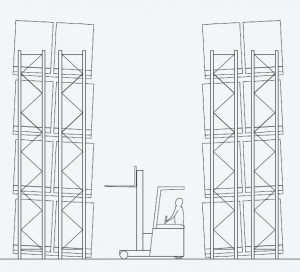 Features
Features
Clear aisles of 3 to 3.4 m
First in last out (FILO) for each slot
Can be three or four pallets deep, but commonly only two pallets deep
Pallets are pushed back from aisle by fork lift trucks
Pallets are placed on low friction carts
Used for full pallet storage only
Forklift drivers need to be careful when loading in an out to avoid pallet damage
Utilization: 85-90%
When do you use it?
When you have more pallets per SKU and want to gain greater storage density
When order picking is not required from pallets within push back racking
When not to use it?
When you need to perform order picking from pallets
When pallets are accessed frequently for picking and are then put away again
Where pallet to pallet contact is can cause damage to stock
3. Racking Mode: Double Deep Racking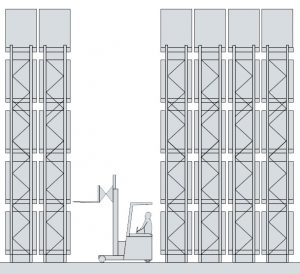 Features
Features
Clear aisle of 3.0 to 3.4 m
FILO for each slot
Pallets at lower levels must be on beams, and guide rails are used at upper levels
Need a fork lift truck with extendable reach and camera to assist the operator
Generally used for placing two pallets of the same SKU in each double deep slot
Can be serviced by reach and counterbalanced fork lift tricks and order picking machines
Storage Utilization: 85-90%
When do you use it?
When you have more pallets per SKU
When greater storage density is required
When not to use it?
When you need to perform order picking from pallets
When pallets are accessed frequently for picking and are then put away again
When you have lots of SKUs with single pallets in stock
4. Racking Mode: Pallet Live Storage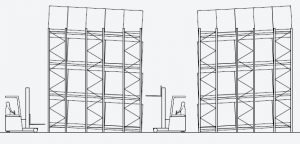 Features
Features
Clear aisle of 3.0 to 3.4 m
FIFO for each lane
Pallets are placed on gravity roll tracks and move from entry to exit via gravitational pull
High use of cube
One lane per SKU
Separate load in and load out aisles
Full pallets only
Utilization: 85-90%
When do you use it?
When you need FIFO Operation and stock is moving at relatively fast rate
When you have a high number of pallets per SKU
Where you need high space utilization
When not to use it?
When you have few pallets per SKU
When you need to perform order picking
When you cannot tolerate pallets encountering others due to line pressure
When you cannot tolerate occasional snags caused by pallets stalling on the roll tracks
5. Racking Mode: Drive in Racking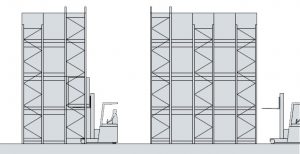 Features:
Features:
Clear Aisles of 3 to 3.4 m for reach trucks or 3.5 to 4.5 m for counter balanced fork lifts
FILO for each ba
The fork lift drives down the lane of each racking bay to deposit or pick up pallets
Drive in racking emulates the operation of block stacking, but with the racking there is reduced damage to pallets and stacking can be higher
Can be up to 10 or 12 pallets deep and up 6 or 7 pallets high
Utilization: 50-60%
When do you use it?
When FILO is not a problem
When you do not wish to mix SKUs within each bay/lane of drive in racking
When high density storage is required, (but be careful of the honeycomb effect) which reduces utilization
When staging of received or picked goods is required in a high-density format
When not to use it?
Where order picking is required from pallets
When you are planning for greater than 60% space utilization
6. Racking Mode: Narrow Aisle Racking (Turret Truck Operation) Features
Features
Clear aisle of 1.8 to 2.2 m
Emulates characteristics of selective racking
Turret trucks retrieve and put away pallets from pick and deposit (P&D) stations at the end of each bay of racking
Turret trucks require wire or mechanical guidance down the length of each aisle
A separate forklift delivers and picks up pallets to and from the P&D stations
Order picking machines may pick from pallets, but not at the same time as turret trucks
Only one machine in an aisle at a time
Utilization: 90%
When do you use it?
When you have a high SKUs with relatively small quantities per SKU
Where you want good space utilization
When you have large amounts of goods moving and out
When you want to improve the storage density within your warehouse
When not to use it?
When you can’t afford to two machines operating
When you have limited budget
When you have a high movement velocity and need two machines working in the same aisle at the same time
7. Racking Mode: Narrow Aisle Racking (Articulated Truck)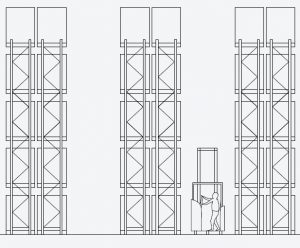 Features
Features
Clear aisle of 1.8 to 2.2 m
Emulates characteristics of selective racking
Articulated reach trucks can move from truck unloading to rack without the need for (P&D) stations or guidance
Order picking machines may pick from pallets, but not at the same time as turret trucks
Only one machine in an aisle at a time
Utilization 90%
When do you use it?
When you have a high SKUs with relatively small quantities per SKU
Where you want good space utilization
When you have large amounts of goods moving and out
When you want to improve the storage density within your warehouse
When not to use it?
When you want one machine servicing the racking
When you have a high movement velocity and need two machines working in the same aisle at the same time
8. Racking Mode: Mobile Racking Features
Features
Clear aisle of 3 to 3.4 m
Mobile bases with wheels support selective racking
Operates like a powered compactus
Mobile racks move to allow access to pallets
One aisle opens at a time
Ideal for high density storage, with maximum selectivity
Often used in cool and cold stores
Utilization: 90%
When do you use it?
Use when there is a high amount of storage, but with modest movement of pallets
When you are handling full pallets only
When building and operating expenses are high e.g. cool and cold stores
When not to use it?
When space is not at a premium
When you need to perform lots of carton picking from pallets
When you need operate in more than one aisle at a time
9. Racking Mode: Satellite Racking (Deep Lane Pallet Racking)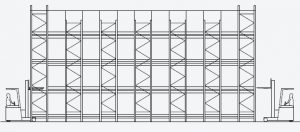 Features
Features
Clear aisle of 3 to 3.4 m
High density storage system, which utilizes a mobile shuttle (remotely controlled) to move the pallets through the racking
Can be 10 to 40 pallets long per lane
The shuttles are placed and retrieved from the racking by fork lift trucks
Can operate in FIFO and FILO modes
Often used as an alternative to drive in racking, because the utilization is much higher
Utilization: 90 to 95%
When do you use it?
Used when there is a high volume of products moving through of each SKUs
One SKU per lane
Used to overcome the poor space utilization of drive in racking
When not to use it?
When you need to pick from the pallets
10. Racking Mode: High Rise Racking (Automated Storage and Retrieval Systems)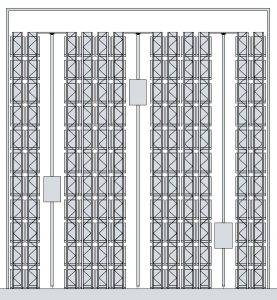 Features
Features
Clear aisle of 1.8 to 2 m
High density storage system usually serviced by automated cranes. Can be single or multiple pallets deep, open or closed face
Needs dedicated building, rack clad or free standing
Utilization: 90 to 95%
When do you use it?
Use when land space is limited, and/or if there is a high volume of products moving in and out of the system
The number of pallets per SKU becomes irrelevant as the system is automatic and all pallets are accessible
When not to use it?
When budget is limited
You do not need to pick from pallets (If you do these can be done elsewhere in the distribution center)
1. Racking Mode: Selective.
 Features
Features
Clear Aisles of 3 to 3.4 m for reach trucks or 3.5 to 4.5 m for counter balanced fork lifts.
Supports First in First Out (FIFO)
Most common mode of racking
Unfettered access to any pallet
Allows order picking at lower levels
Storage Utilization: 90%
I.e. for every 100 pallet places available, you can fill 90.
When do you use it?
Where you have a relatively low number of pallets per SKU
When you want totally free access to any pallet, any time
When you need to pick from pallets at lower levels
When not to use it?
When you have a high number of pallets per SKU and you are constrained for space
When you need to pick from more pallets than the lower level pick face will allow
2. Racking Mode: Push Back Racking
 Features
Features
Clear aisles of 3 to 3.4 m
First in last out (FILO) for each slot
Can be three or four pallets deep, but commonly only two pallets deep
Pallets are pushed back from aisle by fork lift trucks
Pallets are placed on low friction carts
Used for full pallet storage only
Forklift drivers need to be careful when loading in an out to avoid pallet damage
Utilization: 85-90%
When do you use it?
When you have more pallets per SKU and want to gain greater storage density
When order picking is not required from pallets within push back racking
When not to use it?
When you need to perform order picking from pallets
When pallets are accessed frequently for picking and are then put away again
Where pallet to pallet contact is can cause damage to stock
3. Racking Mode: Double Deep Racking
 Features
Features
Clear aisle of 3.0 to 3.4 m
FILO for each slot
Pallets at lower levels must be on beams, and guide rails are used at upper levels
Need a fork lift truck with extendable reach and camera to assist the operator
Generally used for placing two pallets of the same SKU in each double deep slot
Can be serviced by reach and counterbalanced fork lift tricks and order picking machines
Storage Utilization: 85-90%
When do you use it?
When you have more pallets per SKU
When greater storage density is required
When not to use it?
When you need to perform order picking from pallets
When pallets are accessed frequently for picking and are then put away again
When you have lots of SKUs with single pallets in stock
4. Racking Mode: Pallet Live Storage
 Features
Features
Clear aisle of 3.0 to 3.4 m
FIFO for each lane
Pallets are placed on gravity roll tracks and move from entry to exit via gravitational pull
High use of cube
One lane per SKU
Separate load in and load out aisles
Full pallets only
Utilization: 85-90%
When do you use it?
When you need FIFO Operation and stock is moving at relatively fast rate
When you have a high number of pallets per SKU
Where you need high space utilization
When not to use it?
When you have few pallets per SKU
When you need to perform order picking
When you cannot tolerate pallets encountering others due to line pressure
When you cannot tolerate occasional snags caused by pallets stalling on the roll tracks
5. Racking Mode: Drive in Racking
 Features:
Features:
Clear Aisles of 3 to 3.4 m for reach trucks or 3.5 to 4.5 m for counter balanced fork lifts
FILO for each ba
The fork lift drives down the lane of each racking bay to deposit or pick up pallets
Drive in racking emulates the operation of block stacking, but with the racking there is reduced damage to pallets and stacking can be higher
Can be up to 10 or 12 pallets deep and up 6 or 7 pallets high
Utilization: 50-60%
When do you use it?
When FILO is not a problem
When you do not wish to mix SKUs within each bay/lane of drive in racking
When high density storage is required, (but be careful of the honeycomb effect) which reduces utilization
When staging of received or picked goods is required in a high-density format
When not to use it?
Where order picking is required from pallets
When you are planning for greater than 60% space utilization
6. Racking Mode: Narrow Aisle Racking (Turret Truck Operation)
 Features
Features
Clear aisle of 1.8 to 2.2 m
Emulates characteristics of selective racking
Turret trucks retrieve and put away pallets from pick and deposit (P&D) stations at the end of each bay of racking
Turret trucks require wire or mechanical guidance down the length of each aisle
A separate forklift delivers and picks up pallets to and from the P&D stations
Order picking machines may pick from pallets, but not at the same time as turret trucks
Only one machine in an aisle at a time
Utilization: 90%
When do you use it?
When you have a high SKUs with relatively small quantities per SKU
Where you want good space utilization
When you have large amounts of goods moving and out
When you want to improve the storage density within your warehouse
When not to use it?
When you can’t afford to two machines operating
When you have limited budget
When you have a high movement velocity and need two machines working in the same aisle at the same time
7. Racking Mode: Narrow Aisle Racking (Articulated Truck)
 Features
Features
Clear aisle of 1.8 to 2.2 m
Emulates characteristics of selective racking
Articulated reach trucks can move from truck unloading to rack without the need for (P&D) stations or guidance
Order picking machines may pick from pallets, but not at the same time as turret trucks
Only one machine in an aisle at a time
Utilization 90%
When do you use it?
When you have a high SKUs with relatively small quantities per SKU
Where you want good space utilization
When you have large amounts of goods moving and out
When you want to improve the storage density within your warehouse
When not to use it?
When you want one machine servicing the racking
When you have a high movement velocity and need two machines working in the same aisle at the same time
8. Racking Mode: Mobile Racking
 Features
Features
Clear aisle of 3 to 3.4 m
Mobile bases with wheels support selective racking
Operates like a powered compactus
Mobile racks move to allow access to pallets
One aisle opens at a time
Ideal for high density storage, with maximum selectivity
Often used in cool and cold stores
Utilization: 90%
When do you use it?
Use when there is a high amount of storage, but with modest movement of pallets
When you are handling full pallets only
When building and operating expenses are high e.g. cool and cold stores
When not to use it?
When space is not at a premium
When you need to perform lots of carton picking from pallets
When you need operate in more than one aisle at a time
9. Racking Mode: Satellite Racking (Deep Lane Pallet Racking)
 Features
Features
Clear aisle of 3 to 3.4 m
High density storage system, which utilizes a mobile shuttle (remotely controlled) to move the pallets through the racking
Can be 10 to 40 pallets long per lane
The shuttles are placed and retrieved from the racking by fork lift trucks
Can operate in FIFO and FILO modes
Often used as an alternative to drive in racking, because the utilization is much higher
Utilization: 90 to 95%
When do you use it?
Used when there is a high volume of products moving through of each SKUs
One SKU per lane
Used to overcome the poor space utilization of drive in racking
When not to use it?
When you need to pick from the pallets
10. Racking Mode: High Rise Racking (Automated Storage and Retrieval Systems)
 Features
Features
Clear aisle of 1.8 to 2 m
High density storage system usually serviced by automated cranes. Can be single or multiple pallets deep, open or closed face
Needs dedicated building, rack clad or free standing
Utilization: 90 to 95%
When do you use it?
Use when land space is limited, and/or if there is a high volume of products moving in and out of the system
The number of pallets per SKU becomes irrelevant as the system is automatic and all pallets are accessible
When not to use it?
When budget is limited
You do not need to pick from pallets (If you do these can be done elsewhere in the distribution center)
